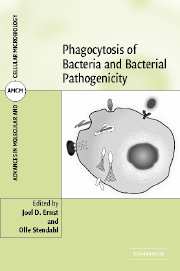Book contents
- Frontmatter
- Contents
- List of contributors
- 1 Introduction
- 2 Phagocytosis: receptors and biology
- 3 Receptor-initiated signal transduction during phagocytosis
- 4 Life, death, and inflammation: manipulation of phagocyte function by Helicobacter pylori
- 5 Phagocytosis of Streptococcus pneumoniae
- 6 Yersinia inhibition of phagocytosis
- 7 Listeria invasion and spread in non-professional phagocytes
- 8 Mycobacterium tuberculosis: mechanisms of phagocytosis and intracellular survival
- Index
- Plate section
- References
7 - Listeria invasion and spread in non-professional phagocytes
Published online by Cambridge University Press: 07 August 2009
- Frontmatter
- Contents
- List of contributors
- 1 Introduction
- 2 Phagocytosis: receptors and biology
- 3 Receptor-initiated signal transduction during phagocytosis
- 4 Life, death, and inflammation: manipulation of phagocyte function by Helicobacter pylori
- 5 Phagocytosis of Streptococcus pneumoniae
- 6 Yersinia inhibition of phagocytosis
- 7 Listeria invasion and spread in non-professional phagocytes
- 8 Mycobacterium tuberculosis: mechanisms of phagocytosis and intracellular survival
- Index
- Plate section
- References
Summary
INTRODUCTION
The intracellular pathogen Listeria monocytogenes exploits a number of normal host cell functions to survive and spread; its intracellular lifestyle explains many of the unique clinical characteristics of this deadly food-borne pathogen (Southwick & Purich 1996). Listeria is able to grow on refrigerated foods and also multiplies readily at room temperature. Humans with defects in cell-mediated immunity who ingest foods stored for prolonged periods in the refrigerator are at risk of contracting Listeria. When ingested in high numbers, this bacterium can quietly enter through the gastrointestinal tract, seed the bloodstream, and subsequently invade the meninges, causing serious and often fatal bacterial meningitis. Based on epidemiologic studies, defects in humoral immunity are not associated with an increased risk of contracting Listeria; however, defects in cell-mediated immunity (particularly in patients with CD4 counts below 200) confer an increased predisposition for listeriosis. Pregnant women, neonates, patients receiving corticosteroids and other immunosuppressants to prevent the rejection of organ transplants or to treat connective tissue disease, and patients with AIDS, are all at increased risk of developing Listeria infection (Lorber 1997). Because Listeria can grow within the cytoplasm of host cells and spread from cell to cell without ever coming in contact with the extracellular milieu, this pathogen is able to avoid antibodies as well as extracellular antibiotics, and can only be killed by cell-mediated immune mechanisms.
- Type
- Chapter
- Information
- Phagocytosis of Bacteria and Bacterial Pathogenicity , pp. 219 - 245Publisher: Cambridge University PressPrint publication year: 2006



